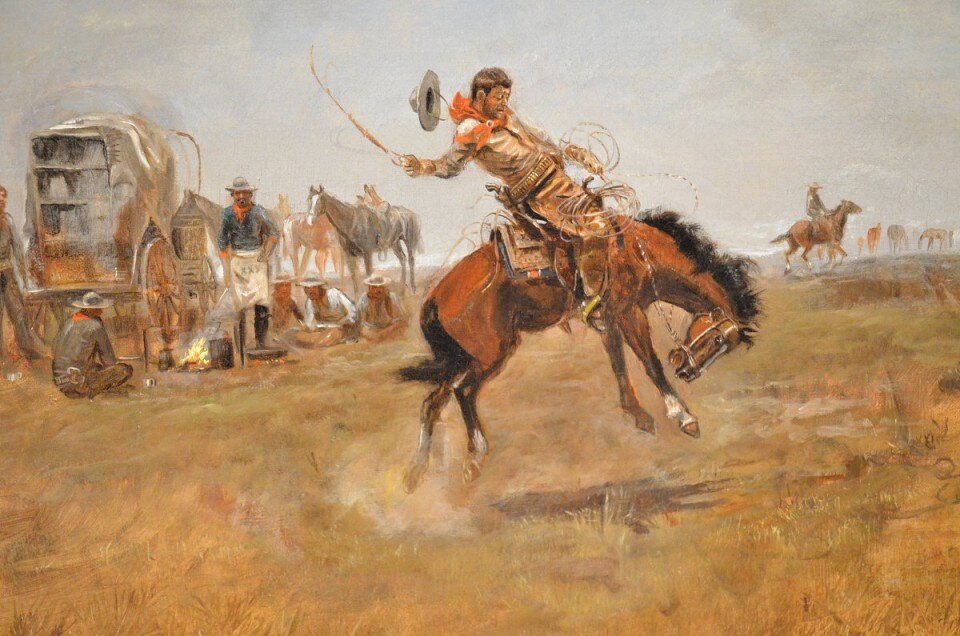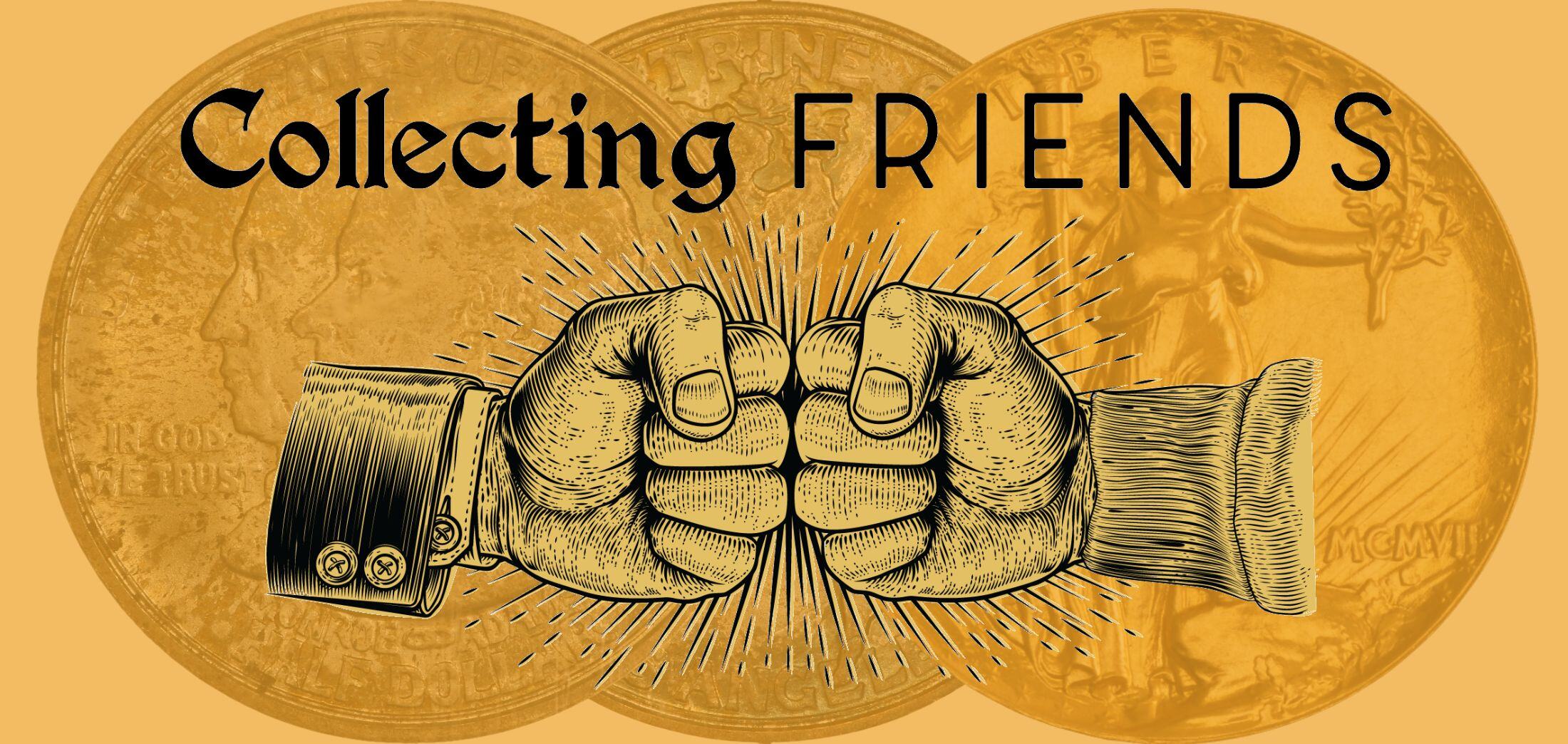Collecting Friends: Small Sculptures
Small Sculptures
Dennis: I was talking with some postcard-collector friends and they told me how their hobby puts a world of art at their fingertips. Deltiologists, as they’re called, can have an entire gallery of masterworks framed and hung in their hallway or den without spending a fortune. If you collect Western art, postcards featuring paintings of the prolific Charles M. Russell are easy to acquire. If pretty girls catch your eye, postcards of Charles Dana Gibson and Howard Chandler Christy are plentiful. If you like Art Nouveau, you can collect postcards of Alphonse Mucha.

Image: Rider of the Rough String by Charles Marion Russell, 1890,
A fan of Mucha doesn’t need to buy a rare full-sized Champenois poster of his work for $20,000 or more. He can enjoy a desirable antique Mucha postcard in fine condition for $200.
Fans of American sculpture artists have similar opportunities, even if most of a sculptor’s famous works are massive and monumental, because some such artists also designed coins and medals. Not only are these works smaller, but enough of them exist that many people can collect them. Admirers of Augustus Saint-Gaudens, Adolph Weinman, James Earle Fraser, and other American artists can easily buy and display their favorites in small scale.
I see that a marble bust of Young Emperor Augustus, made by Augustus Saint-Gaudens circa 1872–1873, recently sold for more than $50,000. For that much money a collector can acquire any but the rarest and finest of Saint-Gaudens twenty-dollar gold coins (minted from 1907 to 1933) in nice Uncirculated condition. In fact, an eye-pleasing Mint State specimen of a common date will cost less than $3,000.
 The Saint-Gaudens double eagle, in addition to its beautiful designs of a magnificent flying eagle and Miss Liberty striding in front of the rising sun, has almost a full ounce of pure gold. It measures more than an inch and a quarter in diameter, big enough to drink in the artist’s finely detailed vision—but much smaller than the Augustus marble bust at eighteen inches and sixty-three pounds!
The Saint-Gaudens double eagle, in addition to its beautiful designs of a magnificent flying eagle and Miss Liberty striding in front of the rising sun, has almost a full ounce of pure gold. It measures more than an inch and a quarter in diameter, big enough to drink in the artist’s finely detailed vision—but much smaller than the Augustus marble bust at eighteen inches and sixty-three pounds!
The Augustus sculpture is one of a kind, and it was on loan to the Metropolitan Museum of Art for almost forty years. Not an easily collectible piece. Another challenging Saint-Gaudens work, in terms of collectability, is the artist’s early-twentieth-century Victory. The monument-sized version is nearly eleven feet tall—an immovable part of the General William Tecumseh Sherman Monument in Grand Army Plaza in Central Park, New York. It was dedicated in 1903. The “collectible” version is a gilded bronze reduction, three and a half feet tall. There are four examples in museums and three that are privately owned. In April 2023 professional numismatist Kevin Lipton bought one of those three—previously in a private collection for decades—for $1,168,400.
Image: A very rare Saint-Gaudens masterpiece worth more than $1 million.
In contrast to those rare pieces, a quick glance at the websites for Heritage Auctions and Stack’s Bowers Galleries shows nearly 700 Saint-Gaudens double eagles up for bid. And hundreds of U.S. coin dealers have them in retail stock.
Steve, I know you collect sculpture as well as coins. What are your thoughts on the relationship between artists’ “big” works and their smaller cousins?
 Steve: Dennis! I love this prompt because it is at the intersections of my two main interests: art and coins. A friend of mine put together a collection of small-scale sculpture made by artists who also designed coins. He lamented that his budget kept him from acquiring a significant non-numismatic sculpture by Augustus Saint-Gaudens, but sharp-eyed collectors can find plenty of wonderful works by coin designers for reasonable prices.
Steve: Dennis! I love this prompt because it is at the intersections of my two main interests: art and coins. A friend of mine put together a collection of small-scale sculpture made by artists who also designed coins. He lamented that his budget kept him from acquiring a significant non-numismatic sculpture by Augustus Saint-Gaudens, but sharp-eyed collectors can find plenty of wonderful works by coin designers for reasonable prices.
They look great in a study, or atop a coin cabinet, and collectors of these love the varied surfaces of a marble or bronze sculpture, much like they appreciate toning on a coin.
These affordable works are often at smaller auction houses, and DuMouchelles in Detroit, Michigan offered a few nice ones last year. A modest tabletop bronze sculpture titled Breath of The Pines by Chester Beach [image] – known to numismatists for his 1923-S Monroe Doctrine commemorative half dollar – that depicts a nude woman with her arms above her head. Measuring just over 7 inches with its base, sold for a bid of only $200. It is in the tradition of small-scale bronzes that are meant to be held and considered by a viewer.
Beach had a varied practice, working on large public commissions and smaller private ones, sometimes collaborating with foundries to produce smaller works like Breath of The Pines for collectors. Most sculptors who were Beach’s peers, like Anthony de Francisci (of the famed Peace Dollar), supplemented their income by teaching and were honored in their lifetimes with plenty of awards for excellence in sculpture. However, their numismatic works are best-remembered today, at least by coin collectors.
.jpg?width=932&height=510&name=1923-S%20Monroe%20Doctrine%20commemorative%20half%20dollar%20(1).jpg)
Image: 1923 Monroe Doctrine Centennial Half Dollar
Be on the lookout for another installment of Collecting Friends next month or subscribe here and never miss a post! In the meantime, explore beautiful coins from the ANA's Edward C. Rochette Money Museum Virtual Exhibits.
About the Collecting Friends Blog
Hello! And welcome to the ANA’s blog series, “Collecting Friends.”
We decided to approach this much like a conversation between friends. One of us starts with a topic, then the other responds. Simple as that. Along those lines, we’ll keep the tone conversational as much as possible.
We both write about coins professionally, and will keep our relative style guides in our writing. For Dennis, Publisher at Whitman Publishing, that means capitalizing “Proof” and italicizing Red Book and never saying anything bad about Ken Bressett, who’s awesome anyway.
For Steve, who’s written with Coin World for 15 years, it means Winged Liberty Head dime instead of “Mercury” dime, and similar nuances and oddities. And, it means writing A Guide Book of United States Coins (better known as the “Red Book”).
Both of us started collecting when we were little, introduced to coins by a chance encounter with an old coin that sparked our curiosity. One of Steve’s interests is coin valuation, and he gravitates towards the intersection of art and coins. Dennis enjoys medals and world coins, and studying modern U.S. coins in the context of older series, what came before.
We met in 2012 at the American Numismatic Association World’s Fair of Money in Philadelphia at an event hosted by the Austrian Mint where there was both a Ben Franklin and a Betsy Ross impersonator. We’ve become great friends in the past decade. We even were appointed together to sit on the Citizens Coinage Advisory Committee starting in 2016, but Steve resigned soon after he was appointed to accept a full-time job at the Treasury Department while Dennis was re-appointed in 2020.
We taught a course together on numismatic publishing and writing a few years ago at the Summer Seminar, and while life has gotten in the way of us teaching another class, we jumped at our friend Caleb’s suggestion that we write a column. We hope you enjoy it!
.png?width=300&height=300&name=steve%20roach%20circle%20frame%20(2).png)
.png?width=300&height=300&name=dennis%20tucker%20circle%20frame%20(2).png)
About the American Numismatic Association
The American Numismatic Association is a nonprofit organization dedicated to educating and encouraging people to study and collect coins and related items. The Association serves collectors, the general public, and academic communities with an interest in numismatics.
The ANA helps all people discover and explore the world of money through its vast array of educational programs including its museum, library, publications, conventions and numismatic seminars

